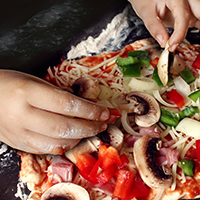Ways to encourage healthy eating with your child

We know how hard (and frustrating) it can be to see another healthy homecooked meal go into the bin, untouched. But don’t give up just yet! Jane Rylands, from family appliance providers Belling, shares her tips for getting kids to enjoy eating healthy foods.
 Despite your best efforts, it can be quite a challenge to get your kids to eat well. In fact, a third of UK home cooks admitted that their homemade meals regularly end up in the bin (Belling), and many homes have to make multiple meals a night just to cater to everyone’s tastes. Some children will avoid all fruits and vegetables, others refuse to try new things. Some don’t enjoy eating at all, which can be quite distressing for parents who want to see them grow up happy and healthy.
Despite your best efforts, it can be quite a challenge to get your kids to eat well. In fact, a third of UK home cooks admitted that their homemade meals regularly end up in the bin (Belling), and many homes have to make multiple meals a night just to cater to everyone’s tastes. Some children will avoid all fruits and vegetables, others refuse to try new things. Some don’t enjoy eating at all, which can be quite distressing for parents who want to see them grow up happy and healthy.
All these fussy behaviours mean that mealtimes are often a struggle and can be a stressful part of the day for everyone involved. So, here are some simple yet effective ways to get your little ones to eat their five-a-day with minimal fuss.
Fun foodie games
If your kids are fussy, especially when it comes to fruits, vegetables, and trying new things, it could help to make mealtimes more exciting rather than something to be dreaded. Look for games or reward systems that can get your children interested in trying new foods. Here’s a few you could try to get you started:

- The World Tour: Take a globe or map and ask your children to pick a country, then find healthy recipes from that culture for them to try. If they eat the food, they get a stamp in a homemade passport. This appears to put them in control of what you’re having for dinner tonight (although you’ll be sneaking veggies into the recipes either way) and gives them a choice. Why not turn it into a competition to see who can discover the tastiest, exotic food?
- The Portion Game: Everyone knows you should be eating five fruits and vegetables a day, and it’s good for children to learn early on that there are certain amounts of different foods that they should be eating. Seeing it laid out on a chart can turn it into a fun game — who will be the first to get to five portions today?
- The Scavenger Hunt: This game is less about cooking and more about food shopping, which is an equally important part of establishing a healthy diet. Give your children a shopping list each when you go to the supermarket that encourages them to search and explore the fresh produce sections. They’ll be excited about the fruits and vegetables they’ve managed to tick off their list, and much more likely to try them later when you get home.
Get them cooking and creating their own dishes
 If getting your children to eat often feels like a power struggle, it could help to give them more control over the making of their meals. Learning to cook early on is a life skill that will give them more independence, but it also helps kids to understand the time, effort, and methods used to produce their dinner. It can also tempt them to try new ingredients and combinations that they wouldn’t otherwise eat but, because it was their decision to make it, they’re more likely to enjoy.
If getting your children to eat often feels like a power struggle, it could help to give them more control over the making of their meals. Learning to cook early on is a life skill that will give them more independence, but it also helps kids to understand the time, effort, and methods used to produce their dinner. It can also tempt them to try new ingredients and combinations that they wouldn’t otherwise eat but, because it was their decision to make it, they’re more likely to enjoy.
Start simple by giving them sliced bread and a range of healthy fillings so they can build their own sandwich, instead of making one for them. Or, give them a selection of chopped vegetables to top their pizza with. Once they’re confident with selecting basic ingredients, you can move on to trying some simple recipes together. If you can, try to get them making enough for everyone so they get the satisfaction of watching their whole family eat something they have made.
Become a role model
The best thing you can do to establish healthy eating habits in your children is to lead by example. Become their healthy role model by making the whole family, not just the children, eat their fruits, vegetables, and healthy dinners and finish every meal, even if it’s not their favourite; it normalises this behaviour and makes children more likely to sustain a good diet throughout their lives. Not only will mealtimes be less of a struggle, but you’ll also feel the benefit of healthy eating for yourself.
Following the tips in this guide should help to alleviate some of the pressures of teatime and can be used to encourage picky eaters to enjoy healthy food.



